Analysis of Strategic Information Systems at Toyota Motor Corporation
VerifiedAdded on 2020/05/28
|7
|2466
|55
Report
AI Summary
This report provides an in-depth analysis of Strategic Information Systems (SIS) using Toyota Motor Corporation (TMC) as a case study. It begins with an introduction to SIS and its role in providing a competitive advantage. The report then examines TMC's current processes, including its unique production method and global strategy, and identifies gaps in market segmentation. A proposed solution involving an intelligent data analysis system is presented to address these gaps. The report also outlines the information system strategy, including tasks like developing a strategic vision, setting objectives, and formulating a strategy. It discusses the different levels of strategy, such as corporate, business unit, and operational levels, focusing on TMC's business unit strategy. The analysis explores how SIS can be utilized for innovation, cost reduction, growth promotion, differentiation, and alliances. The report also addresses the difficulties in developing SIS, such as a lack of experts, high costs, and organizational politics, and potential system failures related to data processing power. Finally, the report discusses references and bibliography.

COVER PAGE
Secure Best Marks with AI Grader
Need help grading? Try our AI Grader for instant feedback on your assignments.
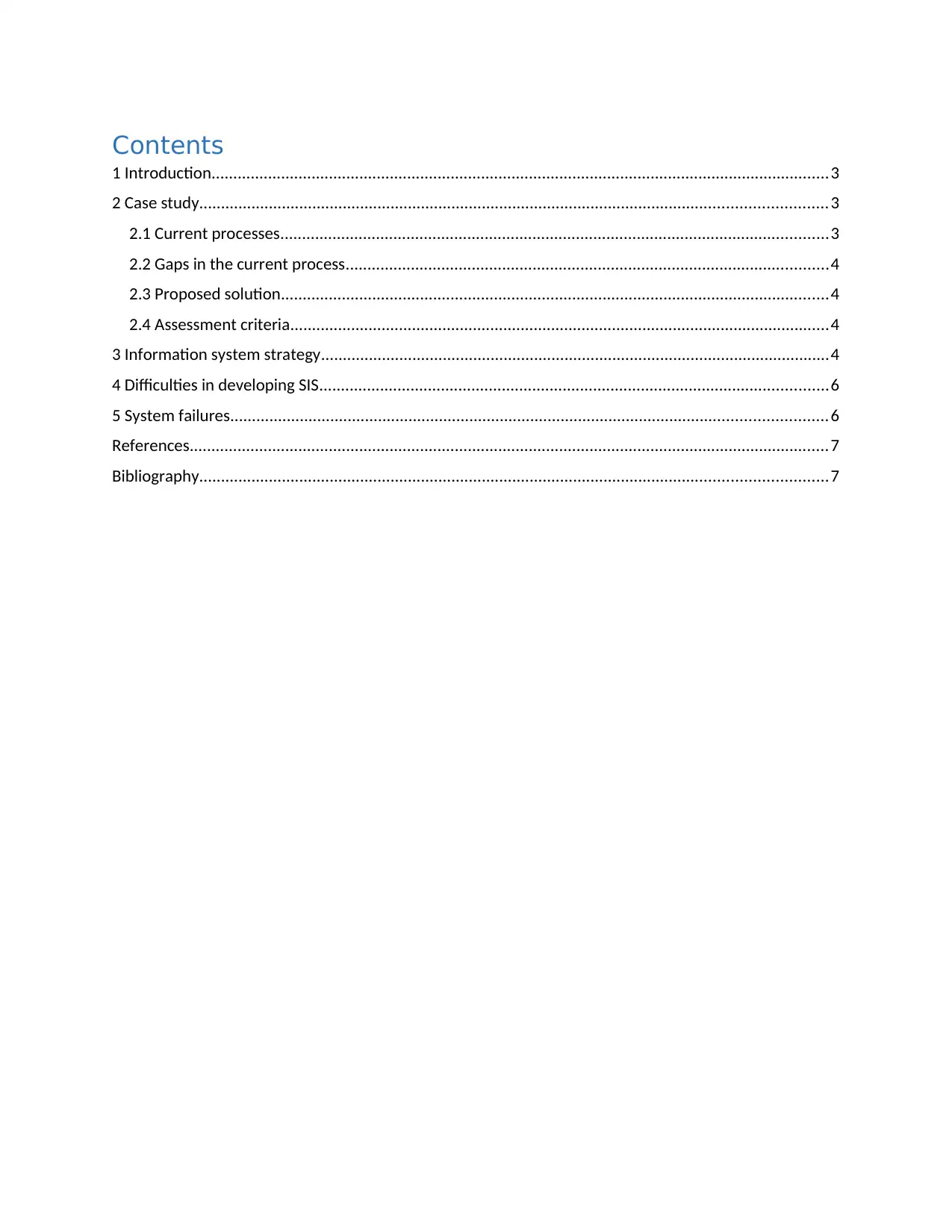
Contents
1 Introduction..............................................................................................................................................3
2 Case study................................................................................................................................................3
2.1 Current processes..............................................................................................................................3
2.2 Gaps in the current process...............................................................................................................4
2.3 Proposed solution..............................................................................................................................4
2.4 Assessment criteria............................................................................................................................4
3 Information system strategy.....................................................................................................................4
4 Difficulties in developing SIS.....................................................................................................................6
5 System failures.........................................................................................................................................6
References...................................................................................................................................................7
Bibliography................................................................................................................................................7
1 Introduction..............................................................................................................................................3
2 Case study................................................................................................................................................3
2.1 Current processes..............................................................................................................................3
2.2 Gaps in the current process...............................................................................................................4
2.3 Proposed solution..............................................................................................................................4
2.4 Assessment criteria............................................................................................................................4
3 Information system strategy.....................................................................................................................4
4 Difficulties in developing SIS.....................................................................................................................6
5 System failures.........................................................................................................................................6
References...................................................................................................................................................7
Bibliography................................................................................................................................................7
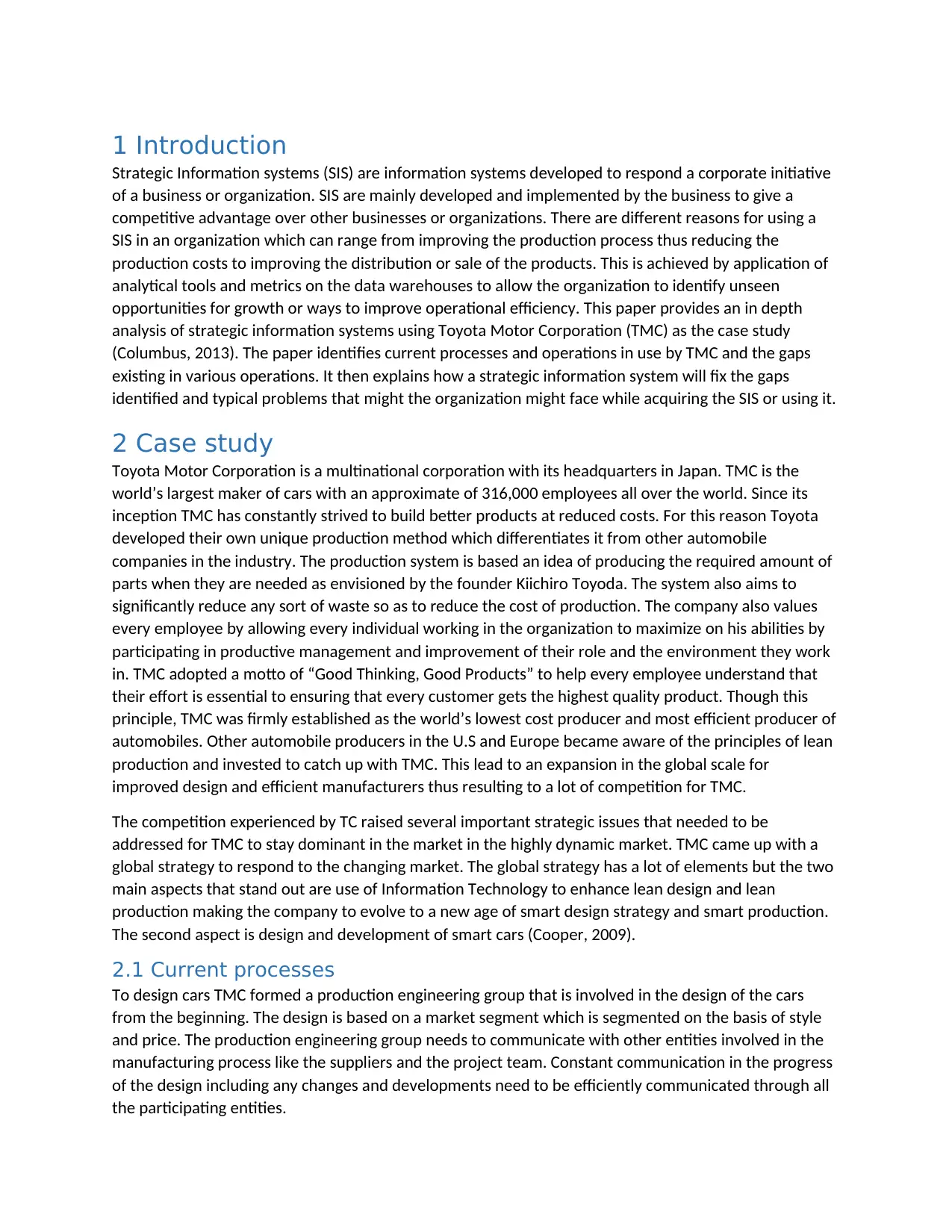
1 Introduction
Strategic Information systems (SIS) are information systems developed to respond a corporate initiative
of a business or organization. SIS are mainly developed and implemented by the business to give a
competitive advantage over other businesses or organizations. There are different reasons for using a
SIS in an organization which can range from improving the production process thus reducing the
production costs to improving the distribution or sale of the products. This is achieved by application of
analytical tools and metrics on the data warehouses to allow the organization to identify unseen
opportunities for growth or ways to improve operational efficiency. This paper provides an in depth
analysis of strategic information systems using Toyota Motor Corporation (TMC) as the case study
(Columbus, 2013). The paper identifies current processes and operations in use by TMC and the gaps
existing in various operations. It then explains how a strategic information system will fix the gaps
identified and typical problems that might the organization might face while acquiring the SIS or using it.
2 Case study
Toyota Motor Corporation is a multinational corporation with its headquarters in Japan. TMC is the
world’s largest maker of cars with an approximate of 316,000 employees all over the world. Since its
inception TMC has constantly strived to build better products at reduced costs. For this reason Toyota
developed their own unique production method which differentiates it from other automobile
companies in the industry. The production system is based an idea of producing the required amount of
parts when they are needed as envisioned by the founder Kiichiro Toyoda. The system also aims to
significantly reduce any sort of waste so as to reduce the cost of production. The company also values
every employee by allowing every individual working in the organization to maximize on his abilities by
participating in productive management and improvement of their role and the environment they work
in. TMC adopted a motto of “Good Thinking, Good Products” to help every employee understand that
their effort is essential to ensuring that every customer gets the highest quality product. Though this
principle, TMC was firmly established as the world’s lowest cost producer and most efficient producer of
automobiles. Other automobile producers in the U.S and Europe became aware of the principles of lean
production and invested to catch up with TMC. This lead to an expansion in the global scale for
improved design and efficient manufacturers thus resulting to a lot of competition for TMC.
The competition experienced by TC raised several important strategic issues that needed to be
addressed for TMC to stay dominant in the market in the highly dynamic market. TMC came up with a
global strategy to respond to the changing market. The global strategy has a lot of elements but the two
main aspects that stand out are use of Information Technology to enhance lean design and lean
production making the company to evolve to a new age of smart design strategy and smart production.
The second aspect is design and development of smart cars (Cooper, 2009).
2.1 Current processes
To design cars TMC formed a production engineering group that is involved in the design of the cars
from the beginning. The design is based on a market segment which is segmented on the basis of style
and price. The production engineering group needs to communicate with other entities involved in the
manufacturing process like the suppliers and the project team. Constant communication in the progress
of the design including any changes and developments need to be efficiently communicated through all
the participating entities.
Strategic Information systems (SIS) are information systems developed to respond a corporate initiative
of a business or organization. SIS are mainly developed and implemented by the business to give a
competitive advantage over other businesses or organizations. There are different reasons for using a
SIS in an organization which can range from improving the production process thus reducing the
production costs to improving the distribution or sale of the products. This is achieved by application of
analytical tools and metrics on the data warehouses to allow the organization to identify unseen
opportunities for growth or ways to improve operational efficiency. This paper provides an in depth
analysis of strategic information systems using Toyota Motor Corporation (TMC) as the case study
(Columbus, 2013). The paper identifies current processes and operations in use by TMC and the gaps
existing in various operations. It then explains how a strategic information system will fix the gaps
identified and typical problems that might the organization might face while acquiring the SIS or using it.
2 Case study
Toyota Motor Corporation is a multinational corporation with its headquarters in Japan. TMC is the
world’s largest maker of cars with an approximate of 316,000 employees all over the world. Since its
inception TMC has constantly strived to build better products at reduced costs. For this reason Toyota
developed their own unique production method which differentiates it from other automobile
companies in the industry. The production system is based an idea of producing the required amount of
parts when they are needed as envisioned by the founder Kiichiro Toyoda. The system also aims to
significantly reduce any sort of waste so as to reduce the cost of production. The company also values
every employee by allowing every individual working in the organization to maximize on his abilities by
participating in productive management and improvement of their role and the environment they work
in. TMC adopted a motto of “Good Thinking, Good Products” to help every employee understand that
their effort is essential to ensuring that every customer gets the highest quality product. Though this
principle, TMC was firmly established as the world’s lowest cost producer and most efficient producer of
automobiles. Other automobile producers in the U.S and Europe became aware of the principles of lean
production and invested to catch up with TMC. This lead to an expansion in the global scale for
improved design and efficient manufacturers thus resulting to a lot of competition for TMC.
The competition experienced by TC raised several important strategic issues that needed to be
addressed for TMC to stay dominant in the market in the highly dynamic market. TMC came up with a
global strategy to respond to the changing market. The global strategy has a lot of elements but the two
main aspects that stand out are use of Information Technology to enhance lean design and lean
production making the company to evolve to a new age of smart design strategy and smart production.
The second aspect is design and development of smart cars (Cooper, 2009).
2.1 Current processes
To design cars TMC formed a production engineering group that is involved in the design of the cars
from the beginning. The design is based on a market segment which is segmented on the basis of style
and price. The production engineering group needs to communicate with other entities involved in the
manufacturing process like the suppliers and the project team. Constant communication in the progress
of the design including any changes and developments need to be efficiently communicated through all
the participating entities.
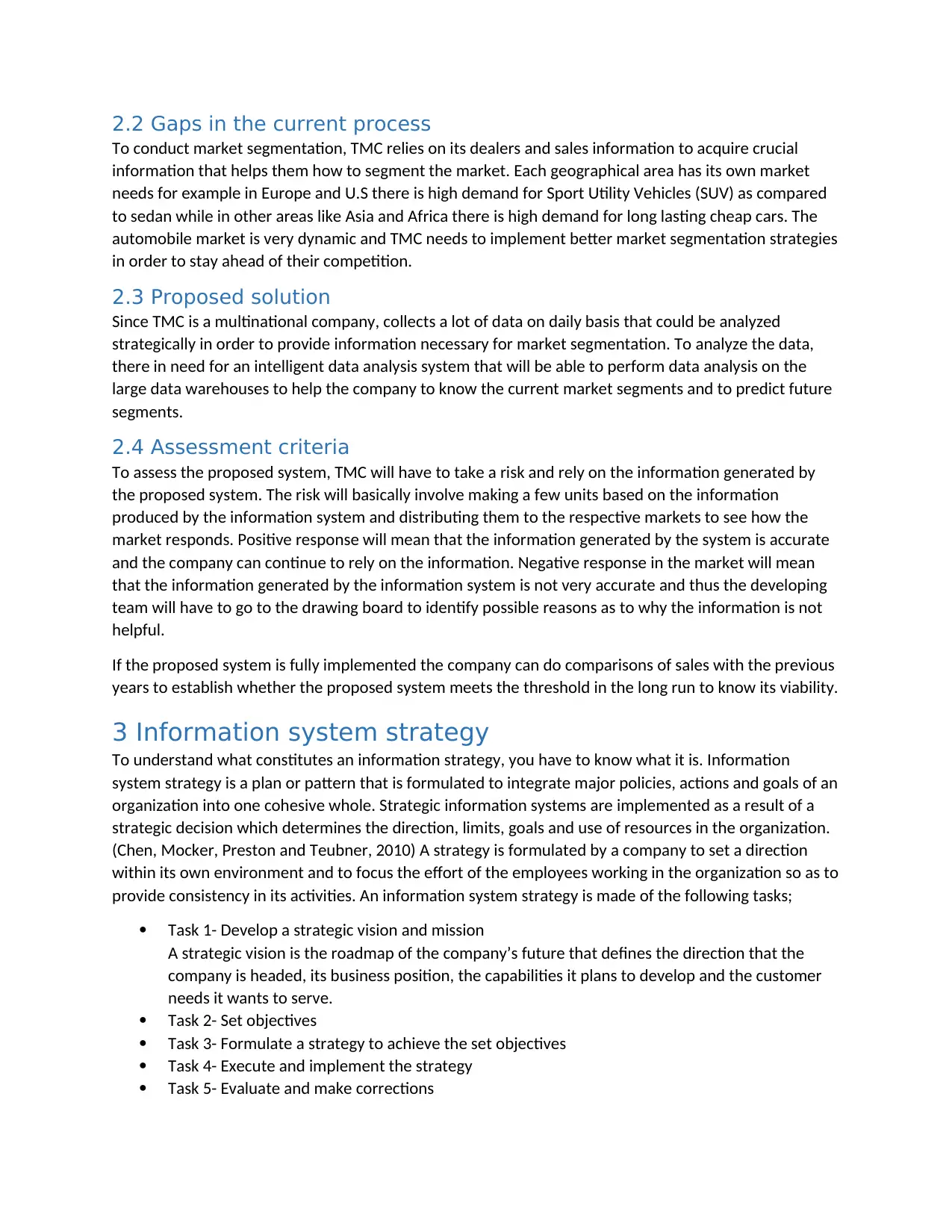
2.2 Gaps in the current process
To conduct market segmentation, TMC relies on its dealers and sales information to acquire crucial
information that helps them how to segment the market. Each geographical area has its own market
needs for example in Europe and U.S there is high demand for Sport Utility Vehicles (SUV) as compared
to sedan while in other areas like Asia and Africa there is high demand for long lasting cheap cars. The
automobile market is very dynamic and TMC needs to implement better market segmentation strategies
in order to stay ahead of their competition.
2.3 Proposed solution
Since TMC is a multinational company, collects a lot of data on daily basis that could be analyzed
strategically in order to provide information necessary for market segmentation. To analyze the data,
there in need for an intelligent data analysis system that will be able to perform data analysis on the
large data warehouses to help the company to know the current market segments and to predict future
segments.
2.4 Assessment criteria
To assess the proposed system, TMC will have to take a risk and rely on the information generated by
the proposed system. The risk will basically involve making a few units based on the information
produced by the information system and distributing them to the respective markets to see how the
market responds. Positive response will mean that the information generated by the system is accurate
and the company can continue to rely on the information. Negative response in the market will mean
that the information generated by the information system is not very accurate and thus the developing
team will have to go to the drawing board to identify possible reasons as to why the information is not
helpful.
If the proposed system is fully implemented the company can do comparisons of sales with the previous
years to establish whether the proposed system meets the threshold in the long run to know its viability.
3 Information system strategy
To understand what constitutes an information strategy, you have to know what it is. Information
system strategy is a plan or pattern that is formulated to integrate major policies, actions and goals of an
organization into one cohesive whole. Strategic information systems are implemented as a result of a
strategic decision which determines the direction, limits, goals and use of resources in the organization.
(Chen, Mocker, Preston and Teubner, 2010) A strategy is formulated by a company to set a direction
within its own environment and to focus the effort of the employees working in the organization so as to
provide consistency in its activities. An information system strategy is made of the following tasks;
Task 1- Develop a strategic vision and mission
A strategic vision is the roadmap of the company’s future that defines the direction that the
company is headed, its business position, the capabilities it plans to develop and the customer
needs it wants to serve.
Task 2- Set objectives
Task 3- Formulate a strategy to achieve the set objectives
Task 4- Execute and implement the strategy
Task 5- Evaluate and make corrections
To conduct market segmentation, TMC relies on its dealers and sales information to acquire crucial
information that helps them how to segment the market. Each geographical area has its own market
needs for example in Europe and U.S there is high demand for Sport Utility Vehicles (SUV) as compared
to sedan while in other areas like Asia and Africa there is high demand for long lasting cheap cars. The
automobile market is very dynamic and TMC needs to implement better market segmentation strategies
in order to stay ahead of their competition.
2.3 Proposed solution
Since TMC is a multinational company, collects a lot of data on daily basis that could be analyzed
strategically in order to provide information necessary for market segmentation. To analyze the data,
there in need for an intelligent data analysis system that will be able to perform data analysis on the
large data warehouses to help the company to know the current market segments and to predict future
segments.
2.4 Assessment criteria
To assess the proposed system, TMC will have to take a risk and rely on the information generated by
the proposed system. The risk will basically involve making a few units based on the information
produced by the information system and distributing them to the respective markets to see how the
market responds. Positive response will mean that the information generated by the system is accurate
and the company can continue to rely on the information. Negative response in the market will mean
that the information generated by the information system is not very accurate and thus the developing
team will have to go to the drawing board to identify possible reasons as to why the information is not
helpful.
If the proposed system is fully implemented the company can do comparisons of sales with the previous
years to establish whether the proposed system meets the threshold in the long run to know its viability.
3 Information system strategy
To understand what constitutes an information strategy, you have to know what it is. Information
system strategy is a plan or pattern that is formulated to integrate major policies, actions and goals of an
organization into one cohesive whole. Strategic information systems are implemented as a result of a
strategic decision which determines the direction, limits, goals and use of resources in the organization.
(Chen, Mocker, Preston and Teubner, 2010) A strategy is formulated by a company to set a direction
within its own environment and to focus the effort of the employees working in the organization so as to
provide consistency in its activities. An information system strategy is made of the following tasks;
Task 1- Develop a strategic vision and mission
A strategic vision is the roadmap of the company’s future that defines the direction that the
company is headed, its business position, the capabilities it plans to develop and the customer
needs it wants to serve.
Task 2- Set objectives
Task 3- Formulate a strategy to achieve the set objectives
Task 4- Execute and implement the strategy
Task 5- Evaluate and make corrections
Secure Best Marks with AI Grader
Need help grading? Try our AI Grader for instant feedback on your assignments.
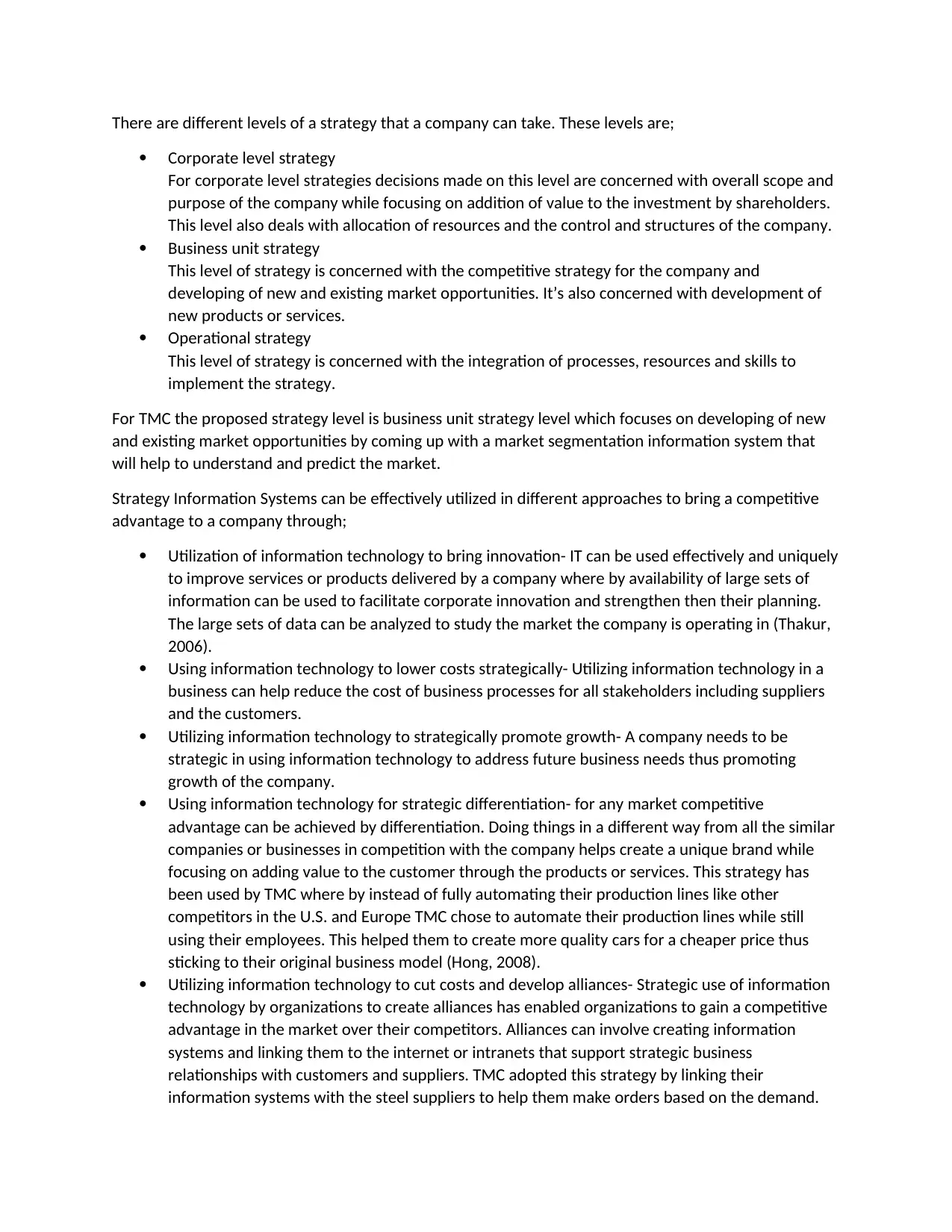
There are different levels of a strategy that a company can take. These levels are;
Corporate level strategy
For corporate level strategies decisions made on this level are concerned with overall scope and
purpose of the company while focusing on addition of value to the investment by shareholders.
This level also deals with allocation of resources and the control and structures of the company.
Business unit strategy
This level of strategy is concerned with the competitive strategy for the company and
developing of new and existing market opportunities. It’s also concerned with development of
new products or services.
Operational strategy
This level of strategy is concerned with the integration of processes, resources and skills to
implement the strategy.
For TMC the proposed strategy level is business unit strategy level which focuses on developing of new
and existing market opportunities by coming up with a market segmentation information system that
will help to understand and predict the market.
Strategy Information Systems can be effectively utilized in different approaches to bring a competitive
advantage to a company through;
Utilization of information technology to bring innovation- IT can be used effectively and uniquely
to improve services or products delivered by a company where by availability of large sets of
information can be used to facilitate corporate innovation and strengthen then their planning.
The large sets of data can be analyzed to study the market the company is operating in (Thakur,
2006).
Using information technology to lower costs strategically- Utilizing information technology in a
business can help reduce the cost of business processes for all stakeholders including suppliers
and the customers.
Utilizing information technology to strategically promote growth- A company needs to be
strategic in using information technology to address future business needs thus promoting
growth of the company.
Using information technology for strategic differentiation- for any market competitive
advantage can be achieved by differentiation. Doing things in a different way from all the similar
companies or businesses in competition with the company helps create a unique brand while
focusing on adding value to the customer through the products or services. This strategy has
been used by TMC where by instead of fully automating their production lines like other
competitors in the U.S. and Europe TMC chose to automate their production lines while still
using their employees. This helped them to create more quality cars for a cheaper price thus
sticking to their original business model (Hong, 2008).
Utilizing information technology to cut costs and develop alliances- Strategic use of information
technology by organizations to create alliances has enabled organizations to gain a competitive
advantage in the market over their competitors. Alliances can involve creating information
systems and linking them to the internet or intranets that support strategic business
relationships with customers and suppliers. TMC adopted this strategy by linking their
information systems with the steel suppliers to help them make orders based on the demand.
Corporate level strategy
For corporate level strategies decisions made on this level are concerned with overall scope and
purpose of the company while focusing on addition of value to the investment by shareholders.
This level also deals with allocation of resources and the control and structures of the company.
Business unit strategy
This level of strategy is concerned with the competitive strategy for the company and
developing of new and existing market opportunities. It’s also concerned with development of
new products or services.
Operational strategy
This level of strategy is concerned with the integration of processes, resources and skills to
implement the strategy.
For TMC the proposed strategy level is business unit strategy level which focuses on developing of new
and existing market opportunities by coming up with a market segmentation information system that
will help to understand and predict the market.
Strategy Information Systems can be effectively utilized in different approaches to bring a competitive
advantage to a company through;
Utilization of information technology to bring innovation- IT can be used effectively and uniquely
to improve services or products delivered by a company where by availability of large sets of
information can be used to facilitate corporate innovation and strengthen then their planning.
The large sets of data can be analyzed to study the market the company is operating in (Thakur,
2006).
Using information technology to lower costs strategically- Utilizing information technology in a
business can help reduce the cost of business processes for all stakeholders including suppliers
and the customers.
Utilizing information technology to strategically promote growth- A company needs to be
strategic in using information technology to address future business needs thus promoting
growth of the company.
Using information technology for strategic differentiation- for any market competitive
advantage can be achieved by differentiation. Doing things in a different way from all the similar
companies or businesses in competition with the company helps create a unique brand while
focusing on adding value to the customer through the products or services. This strategy has
been used by TMC where by instead of fully automating their production lines like other
competitors in the U.S. and Europe TMC chose to automate their production lines while still
using their employees. This helped them to create more quality cars for a cheaper price thus
sticking to their original business model (Hong, 2008).
Utilizing information technology to cut costs and develop alliances- Strategic use of information
technology by organizations to create alliances has enabled organizations to gain a competitive
advantage in the market over their competitors. Alliances can involve creating information
systems and linking them to the internet or intranets that support strategic business
relationships with customers and suppliers. TMC adopted this strategy by linking their
information systems with the steel suppliers to help them make orders based on the demand.
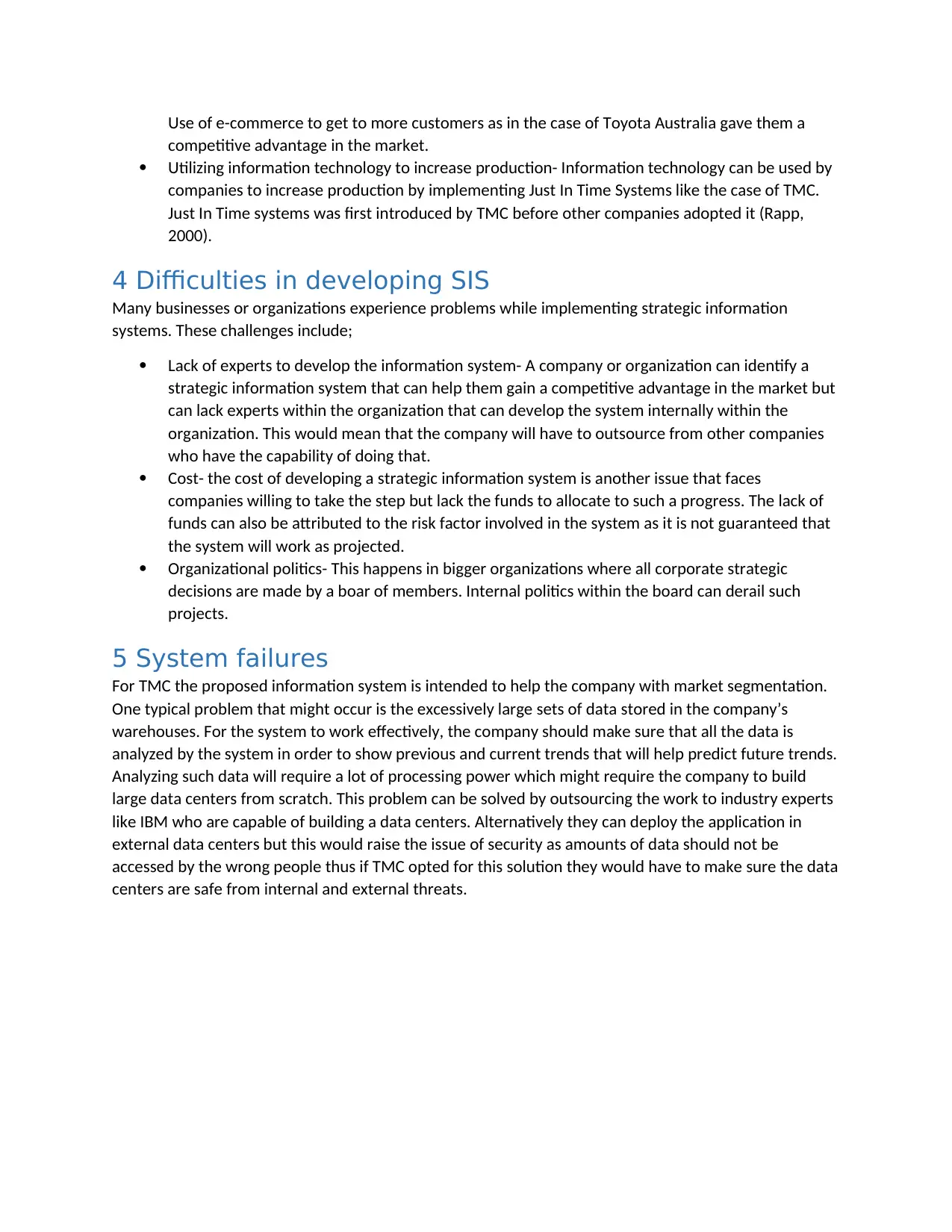
Use of e-commerce to get to more customers as in the case of Toyota Australia gave them a
competitive advantage in the market.
Utilizing information technology to increase production- Information technology can be used by
companies to increase production by implementing Just In Time Systems like the case of TMC.
Just In Time systems was first introduced by TMC before other companies adopted it (Rapp,
2000).
4 Difficulties in developing SIS
Many businesses or organizations experience problems while implementing strategic information
systems. These challenges include;
Lack of experts to develop the information system- A company or organization can identify a
strategic information system that can help them gain a competitive advantage in the market but
can lack experts within the organization that can develop the system internally within the
organization. This would mean that the company will have to outsource from other companies
who have the capability of doing that.
Cost- the cost of developing a strategic information system is another issue that faces
companies willing to take the step but lack the funds to allocate to such a progress. The lack of
funds can also be attributed to the risk factor involved in the system as it is not guaranteed that
the system will work as projected.
Organizational politics- This happens in bigger organizations where all corporate strategic
decisions are made by a boar of members. Internal politics within the board can derail such
projects.
5 System failures
For TMC the proposed information system is intended to help the company with market segmentation.
One typical problem that might occur is the excessively large sets of data stored in the company’s
warehouses. For the system to work effectively, the company should make sure that all the data is
analyzed by the system in order to show previous and current trends that will help predict future trends.
Analyzing such data will require a lot of processing power which might require the company to build
large data centers from scratch. This problem can be solved by outsourcing the work to industry experts
like IBM who are capable of building a data centers. Alternatively they can deploy the application in
external data centers but this would raise the issue of security as amounts of data should not be
accessed by the wrong people thus if TMC opted for this solution they would have to make sure the data
centers are safe from internal and external threats.
competitive advantage in the market.
Utilizing information technology to increase production- Information technology can be used by
companies to increase production by implementing Just In Time Systems like the case of TMC.
Just In Time systems was first introduced by TMC before other companies adopted it (Rapp,
2000).
4 Difficulties in developing SIS
Many businesses or organizations experience problems while implementing strategic information
systems. These challenges include;
Lack of experts to develop the information system- A company or organization can identify a
strategic information system that can help them gain a competitive advantage in the market but
can lack experts within the organization that can develop the system internally within the
organization. This would mean that the company will have to outsource from other companies
who have the capability of doing that.
Cost- the cost of developing a strategic information system is another issue that faces
companies willing to take the step but lack the funds to allocate to such a progress. The lack of
funds can also be attributed to the risk factor involved in the system as it is not guaranteed that
the system will work as projected.
Organizational politics- This happens in bigger organizations where all corporate strategic
decisions are made by a boar of members. Internal politics within the board can derail such
projects.
5 System failures
For TMC the proposed information system is intended to help the company with market segmentation.
One typical problem that might occur is the excessively large sets of data stored in the company’s
warehouses. For the system to work effectively, the company should make sure that all the data is
analyzed by the system in order to show previous and current trends that will help predict future trends.
Analyzing such data will require a lot of processing power which might require the company to build
large data centers from scratch. This problem can be solved by outsourcing the work to industry experts
like IBM who are capable of building a data centers. Alternatively they can deploy the application in
external data centers but this would raise the issue of security as amounts of data should not be
accessed by the wrong people thus if TMC opted for this solution they would have to make sure the data
centers are safe from internal and external threats.
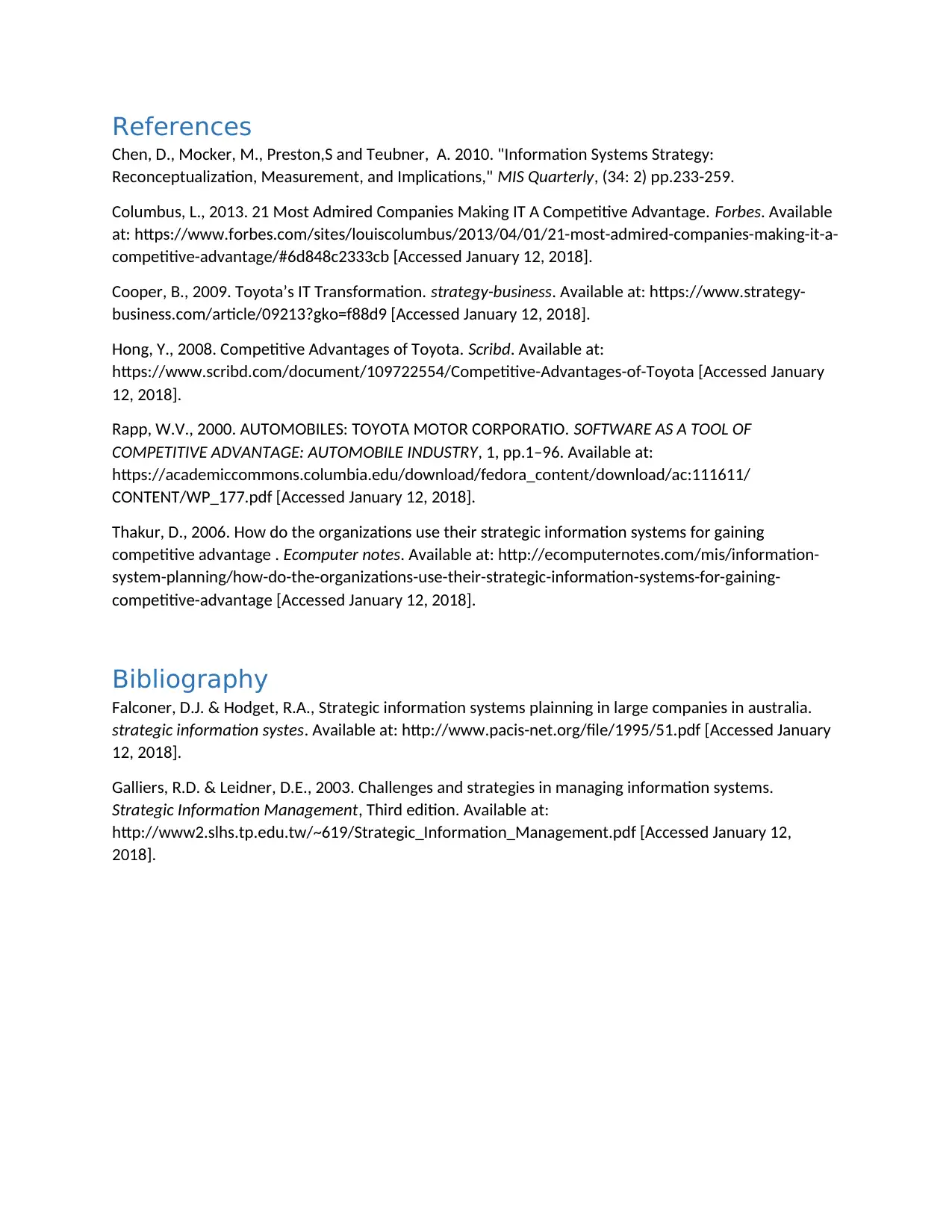
References
Chen, D., Mocker, M., Preston,S and Teubner, A. 2010. "Information Systems Strategy:
Reconceptualization, Measurement, and Implications," MIS Quarterly, (34: 2) pp.233-259.
Columbus, L., 2013. 21 Most Admired Companies Making IT A Competitive Advantage. Forbes. Available
at: https://www.forbes.com/sites/louiscolumbus/2013/04/01/21-most-admired-companies-making-it-a-
competitive-advantage/#6d848c2333cb [Accessed January 12, 2018].
Cooper, B., 2009. Toyota’s IT Transformation. strategy-business. Available at: https://www.strategy-
business.com/article/09213?gko=f88d9 [Accessed January 12, 2018].
Hong, Y., 2008. Competitive Advantages of Toyota. Scribd. Available at:
https://www.scribd.com/document/109722554/Competitive-Advantages-of-Toyota [Accessed January
12, 2018].
Rapp, W.V., 2000. AUTOMOBILES: TOYOTA MOTOR CORPORATIO. SOFTWARE AS A TOOL OF
COMPETITIVE ADVANTAGE: AUTOMOBILE INDUSTRY, 1, pp.1–96. Available at:
https://academiccommons.columbia.edu/download/fedora_content/download/ac:111611/
CONTENT/WP_177.pdf [Accessed January 12, 2018].
Thakur, D., 2006. How do the organizations use their strategic information systems for gaining
competitive advantage . Ecomputer notes. Available at: http://ecomputernotes.com/mis/information-
system-planning/how-do-the-organizations-use-their-strategic-information-systems-for-gaining-
competitive-advantage [Accessed January 12, 2018].
Bibliography
Falconer, D.J. & Hodget, R.A., Strategic information systems plainning in large companies in australia.
strategic information systes. Available at: http://www.pacis-net.org/file/1995/51.pdf [Accessed January
12, 2018].
Galliers, R.D. & Leidner, D.E., 2003. Challenges and strategies in managing information systems.
Strategic Information Management, Third edition. Available at:
http://www2.slhs.tp.edu.tw/~619/Strategic_Information_Management.pdf [Accessed January 12,
2018].
Chen, D., Mocker, M., Preston,S and Teubner, A. 2010. "Information Systems Strategy:
Reconceptualization, Measurement, and Implications," MIS Quarterly, (34: 2) pp.233-259.
Columbus, L., 2013. 21 Most Admired Companies Making IT A Competitive Advantage. Forbes. Available
at: https://www.forbes.com/sites/louiscolumbus/2013/04/01/21-most-admired-companies-making-it-a-
competitive-advantage/#6d848c2333cb [Accessed January 12, 2018].
Cooper, B., 2009. Toyota’s IT Transformation. strategy-business. Available at: https://www.strategy-
business.com/article/09213?gko=f88d9 [Accessed January 12, 2018].
Hong, Y., 2008. Competitive Advantages of Toyota. Scribd. Available at:
https://www.scribd.com/document/109722554/Competitive-Advantages-of-Toyota [Accessed January
12, 2018].
Rapp, W.V., 2000. AUTOMOBILES: TOYOTA MOTOR CORPORATIO. SOFTWARE AS A TOOL OF
COMPETITIVE ADVANTAGE: AUTOMOBILE INDUSTRY, 1, pp.1–96. Available at:
https://academiccommons.columbia.edu/download/fedora_content/download/ac:111611/
CONTENT/WP_177.pdf [Accessed January 12, 2018].
Thakur, D., 2006. How do the organizations use their strategic information systems for gaining
competitive advantage . Ecomputer notes. Available at: http://ecomputernotes.com/mis/information-
system-planning/how-do-the-organizations-use-their-strategic-information-systems-for-gaining-
competitive-advantage [Accessed January 12, 2018].
Bibliography
Falconer, D.J. & Hodget, R.A., Strategic information systems plainning in large companies in australia.
strategic information systes. Available at: http://www.pacis-net.org/file/1995/51.pdf [Accessed January
12, 2018].
Galliers, R.D. & Leidner, D.E., 2003. Challenges and strategies in managing information systems.
Strategic Information Management, Third edition. Available at:
http://www2.slhs.tp.edu.tw/~619/Strategic_Information_Management.pdf [Accessed January 12,
2018].
1 out of 7
Related Documents
Your All-in-One AI-Powered Toolkit for Academic Success.
+13062052269
info@desklib.com
Available 24*7 on WhatsApp / Email
![[object Object]](/_next/static/media/star-bottom.7253800d.svg)
Unlock your academic potential
© 2024 | Zucol Services PVT LTD | All rights reserved.





